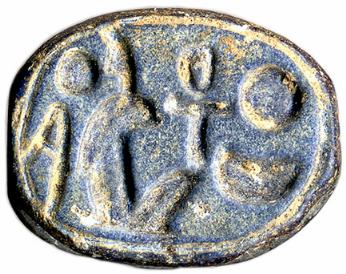
|
|

|
YOU ARE HERE:>>General Information>>Scarabs by Franco Magnarini, section 2, page 6
AN IMPORTANT TUTHMOSIDE FAMILY
Amenhotep III, his wife, the Royal Bride Tiy, and Amenhotep IV-Akhenaton, were father, mother and son; for many reasons, probably the most important family of the XVIII dynasty.

This dark blue faience scarab in imitation of lapis lazuli has horizontally arranged, the prenomen of Amenhotep III: Nb-MAat-Ra followed by the epithet mry Ra. This translates: Amenhotep, beloved of Ra which is a rare epithet.
Only one parallel has been found with this epithet among a considerable number of scarabs of Amenhotep III. See: PETRIE1. This scarab is surely contemporary with the reign of Amenhotep III, (1390-1352 a.C.), also suggested by it's the shape.
Amenhotep III, son of Tuthmosis IV, was the ninth king of this dynasty. His reign was largely peaceful ; he preferred diplomacy and political marriages with related alliances to war. One knows about only one campaign in Nubia against plunderers during his fifth regnal year, while his Asiatic territories were in peace. Amenhotep III was a great builder and during his reign the empire was enriched with splendid monuments, mostly planned by his namesake architect Amenhotep son of Hapu. Of his magnificent funerary temple, collapsed in consequence of an earthquake, there remain in situ only two colossal statues in poor condition, called in Ptolemaic times the Colossuses of Memnon.
He reigned about 38 years. One knows about his jubilees in the 30th , 34th and 37th regnal years. He died in his 39th regnal year and he was buried in the Valley of The Kings (tomb KV22), but his mummy was found in the grave of Amenhotep II, transferred there by priests of XXth dynasty to protect it from pillage and acts of vandalism.
This yellow glazed steatite scarab has vertically arranged, on the right, the cartouche of the queen Tiy (principal wife of Amenhotep III), and on the left the inscription: Hmt nswt wr <t> anxtj = the Great Royal Wife, the living (or may she live).
Cfr.: NEWBERRY2; PETRIE, SCN3; PETRIE, Historical4.
This scarab too is surely datable to XVIII dynasty, the reign of Amenhotep III, because of its shape, the engraving style and quoted parallels.
Queen Tiy exerted much influence over the court. Since the first appearance of her name on the first of five commemorative scarabs issued by Amenhotep III (the only one without date, but probably dating back to the moment of enthronement), she continued to be associated with her husband in the scenes and on the inscriptions during the whole of his reign. She gave birth to six children at least, four girls and two boys: a Tuthmosis who died very young and Amenhotep IV later , Akhenaton. It's believed that the queen was a counsellor of her son , and her daughter-in-law Nefertiti.
This apple green glazed steatite scarab is a rare colour.Horizontally arranged, free in the field, we see the prenomen of Amenhotep IV (then Akhenaton): Nfr-xpr-wra wan Ra = Handsome of figure like Re, the sole of Re. This piece should be dated to between 1353 and 1347 B.C., namely not later than the sixth regnal year of the king, because only at that time did he change his name into Akhenaton.
Cfr.: PETRIE5; BEN-TOR6;HALL7; FRASER8. Surely datable to XVIII dynasty, reign of Akhenaton.
Scarabs bearing the name of this king are quite rare whether this was because during the Amarna period scarab-seals were out of fashion, or because of the damnatio memoriae of which Akhenaton was a victim, we do not know. It's still uncertain if Akhenaton reigned together with his father as a co-regent. He became famous because of his religious conversion which reshaped the worship of Amun , with Aton, the ancient name of the sun, namely the Disc, which became the only divinity. The new cult was disliked by priesthood of Amun as it limited their power and it was condemned as an heresy and was so considered by posterity.
So, these three items have been manufactured during a very short period (probably between 1390 B.C., year of enthronement of Amenhotep III, and 1347 B.C., the sixth regnal year of his son Akhenaton).
1 Flinders Petrie W.M., "HISTORICAL" London-1889, 1242.
2 Newberry P.E., "SCARABS", London -1908, XXXI,4 without anx tj.
3 Flinders Petrie W.M., "SCARABS AND CYLINDERS WITH NAMES", London - 1917, XXXV 18.9, 155/ 156 without anx tj.
4 Flinders Petrie W.M., "HISTORICAL" London-1889, 1300.
5 Flinders Petrie W.M., "SCARABS AND CYLINDERS WITH NAMES", London - 1917, XXXVI 18.10, 2/ 19/ 23 all vertically arranged.
6 Ben-Tor D.,"THE SCARAB..." Jerusalem – 1993, 50, 19.
7 Hall H.R., "CATALOGUE", London -1913, 1953, plaque dated XVIII Dyn.
8 Fraser, G., "A CATALOGUE OF THE SCARABS BELONGING TO GEORGE FRASER" , London-1900, 34, 269.


Home | About This Site | Privacy Statement | Gallery | Testimonials | Guarantees
About Collectors' Resources pages | What's New
Search | Site Map | Contact Us